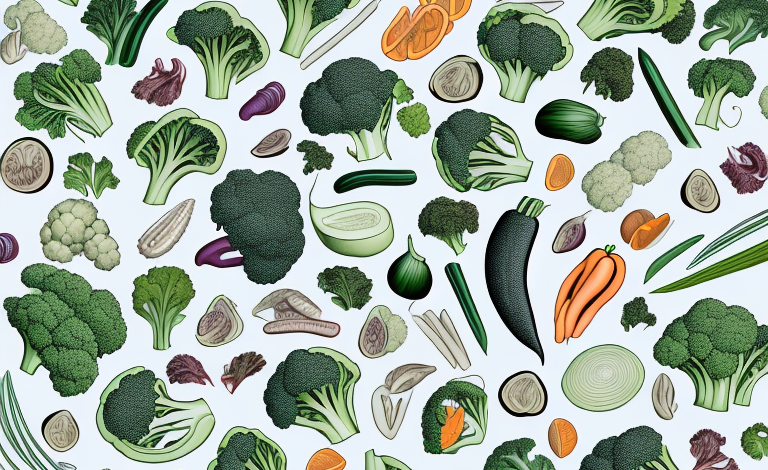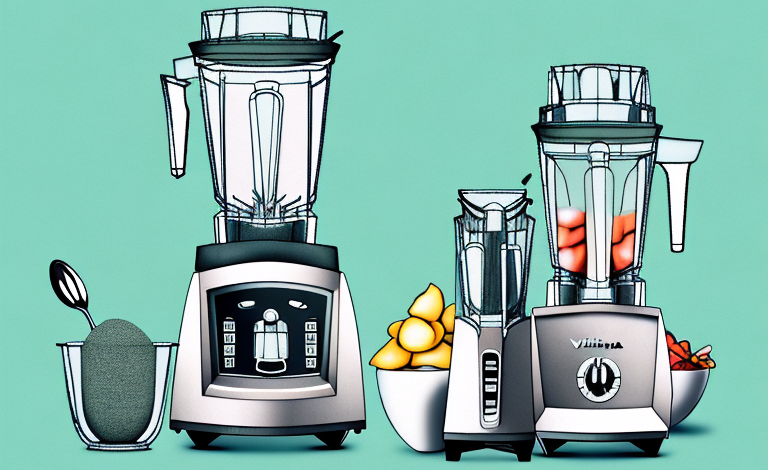The debate around whether or not blending vegetables is superior to eating them whole is ongoing. This article aims to explore the advantages and potential disadvantages of both options and provide insight into which method may be more beneficial for various health goals and lifestyles.
The debate between blending and eating whole vegetables
One of the primary arguments in favor of blending vegetables is that it makes their nutrients more easily accessible to the body. When vegetables are blended, they are broken down into smaller pieces, making it easier for the body to digest and absorb the nutrients they contain. In contrast, eating vegetables whole means the body has to work harder to break down the fibers and extract the nutrients, which can result in less bioavailability of nutrients.
However, proponents of eating whole vegetables argue that consuming fiber-rich whole vegetables can be more beneficial for gut health. Fiber helps promote digestive regularity and can also help prevent certain chronic health conditions such as heart disease and diabetes.
Another consideration in the debate between blending and eating whole vegetables is the impact on satiety. Blending vegetables into a smoothie can result in a drink that is less filling than eating the same amount of whole vegetables. This can lead to overconsumption of calories and potentially contribute to weight gain. On the other hand, eating whole vegetables can provide a greater sense of fullness and satisfaction, which may help with weight management.
Advantages of blending vegetables
Blending vegetables can be beneficial for those who have difficulty consuming enough vegetables in their diet. Blending can help individuals meet their daily recommended servings of fruits and vegetables and can be a quick and convenient way to consume a lot of nutrients in a single sitting.
Another advantage of blending vegetables is that it allows for customization. Individuals can blend various combinations of vegetables and fruits to create a drink tailored to their specific nutritional needs and taste preferences. Adding ingredients such as protein powder, nuts, or seeds can also make for a more satisfying and nutritionally balanced drink.
In addition to the above benefits, blending vegetables can also aid in digestion. Blending breaks down the cell walls of vegetables, making it easier for the body to absorb the nutrients. This can be especially helpful for individuals with digestive issues or those who have difficulty chewing and digesting raw vegetables.
Blending vegetables can also be a great way to reduce food waste. Often, vegetables that are slightly wilted or past their prime can still be used in a blended drink, reducing the amount of food that goes to waste. This can also save money by using up vegetables that might otherwise be thrown away.
Benefits of eating whole vegetables
Eating vegetables whole may be preferable for those who are looking to increase their daily fiber intake. Whole vegetables contain more fiber than blended versions, which can be beneficial for digestive health and weight management.
Eating whole vegetables can also be more satisfying than drinking a blended version. Chewing whole vegetables can help signal to the brain when one is full, reducing the likelihood of overeating or consuming excess calories.
In addition to the benefits mentioned above, eating whole vegetables can also provide a greater variety of nutrients. When vegetables are blended, some of the nutrients may be lost due to oxidation or exposure to air. Eating whole vegetables ensures that all the nutrients are intact and available for the body to absorb.
Furthermore, eating whole vegetables can be a more sustainable option. When vegetables are blended, there is often a lot of waste generated from the pulp and leftover pieces. Eating whole vegetables reduces this waste and can be a more environmentally friendly choice.
Which is more nutritious: blended or whole vegetables?
There is no clear answer as to which option is more nutritious as both have their unique benefits. However, it is important to note that blending vegetables does not negate their nutritional value. Consuming vegetables in any form is better than not consuming them at all.
That being said, blending vegetables can lead to a loss of certain beneficial compounds such as fiber and antioxidants. These compounds can be preserved by consuming vegetable smoothies that still contain some fibrous materials.
Additionally, blending vegetables can make it easier for your body to absorb certain nutrients. For example, blending carrots can increase the bioavailability of beta-carotene, which is important for eye health and immune function. Blending also breaks down the cell walls of vegetables, making it easier for your body to access the nutrients inside.
The impact of blending on nutrient absorption
The blending process can make it easier for the body to absorb certain nutrients such as vitamin C and folate. These nutrients can be damaged during cooking or lost in the digestive process. Blending can help preserve the nutrients and make them more accessible to the body.
In addition, blending can also break down tough plant fibers, making it easier for the body to access other important nutrients such as beta-carotene and lycopene. This is especially beneficial for individuals who may have difficulty chewing or digesting certain foods. However, it is important to note that blending can also increase the glycemic index of certain foods, so it is important to balance blended foods with other nutrient-dense options.
The impact of cooking on nutrient absorption in blended vs. whole vegetables
Cooking vegetables can affect their nutrient content, regardless of whether they are blended or eaten whole. Some nutrients, such as vitamin C, can be lost during cooking, while others, such as lycopene, become more available to the body when heated. If cooking vegetables, it is best to use methods that preserve their nutrients, such as steaming or roasting instead of boiling or frying.
Blending vegetables before cooking can also affect their nutrient absorption. Blending can break down the cell walls of the vegetables, making it easier for the body to absorb certain nutrients, such as beta-carotene. However, blending can also increase the surface area of the vegetables, which can lead to more nutrient loss during cooking. It is important to consider both the cooking method and the preparation method when trying to maximize the nutrient content of your vegetables.
How to maximize the nutritional benefits of blended and whole vegetables
To maximize the nutritional benefits of blended vegetables, consider using a high-powered blender that can create a smooth consistency without removing too much of the fibrous material. To maximize the nutritional benefits of whole vegetables, aim to consume a variety of colors and types of vegetables each day and consider cooking them in ways that preserve their nutrients.
Additionally, it is important to note that some nutrients in vegetables are more easily absorbed by the body when they are cooked. For example, cooking tomatoes can increase the amount of lycopene, a powerful antioxidant, that your body can absorb. However, overcooking vegetables can also lead to nutrient loss, so it is important to find a balance between cooking them enough to increase nutrient absorption and not cooking them too much that the nutrients are lost.
Factors to consider when choosing between blending and eating whole vegetables
When deciding which option is best for you, consider your individual health goals and lifestyle factors. For those who have difficulty consuming enough vegetables in their diet or who are looking for a quick and convenient way to get a lot of nutrients, blending may be the best option. For those who are looking to increase their fiber intake, feel more satisfied after meals, or who enjoy the sensory experience of eating whole foods, eating vegetables whole may be more beneficial.
It is important to note that blending vegetables can break down their cell walls, making the nutrients more easily absorbed by the body. However, this can also lead to a quicker spike in blood sugar levels. On the other hand, eating whole vegetables can help regulate blood sugar levels due to the fiber content, but it may take longer for the body to digest and absorb the nutrients. It is important to consider these factors and consult with a healthcare professional before making a decision on whether to blend or eat whole vegetables.
Blending vs juicing: which is better for nutrition?
While both blending and juicing can be beneficial, they are not the same thing. Juicing typically involves removing the fibrous material from vegetables and fruits, resulting in a drink that is high in nutrients but lower in fiber. Blending involves blending the whole vegetables and fruits, resulting in a thicker drink that still contains the fibrous material. Ultimately, the best option depends on individual health goals and preferences.
It is important to note that while juicing may result in a higher concentration of nutrients, it can also lead to a higher intake of sugar due to the removal of fiber. Fiber helps slow down the absorption of sugar into the bloodstream, which can be beneficial for those with diabetes or blood sugar imbalances. On the other hand, blending can provide a more filling and satisfying drink due to the presence of fiber, which can aid in weight management and digestion. It is recommended to incorporate a variety of fruits and vegetables in both juicing and blending to ensure a well-rounded intake of nutrients.
The role of fiber in blended vs. whole vegetable consumption
Fiber is an essential nutrient that is important for digestive health, promoting feelings of fullness, and reducing the risk of chronic diseases such as heart disease and type 2 diabetes. While blending vegetables can lead to a loss of fiber, it is still possible to include it in blended drinks by including some of the fibrous material in the recipe. Whole vegetables are naturally high in fiber and can be a good addition to a balanced and healthy diet.
The convenience factor: pros and cons of blending vs. eating whole veggies
One of the primary benefits of blending vegetables is that it is a quick and convenient way to consume a lot of nutrients in a single sitting. Blending can be especially beneficial for busy individuals who do not have time to prepare and cook vegetables throughout the day. However, eating vegetables whole can also be convenient, especially when consuming raw vegetables that do not require any preparation.
How to incorporate both blended and whole veggies into your diet for optimal health
The best way to incorporate both blended and whole vegetables into your diet is to aim for variety and balance. Consider keeping a selection of raw vegetables on hand for snacking and adding blended drinks to your daily routine as a quick and easy way to consume additional nutrients.
Top recipes for blended and whole vegetable dishes
Here are a few recipe ideas to help you incorporate both blended and whole vegetables into your diet:
– Smoothie: spinach, apple, and almond milk
– Salad: mixed greens, cherry tomatoes, cucumber, bell peppers, avocado, and grilled chicken
– Stir-fry: broccoli, snap peas, mushrooms, carrots, and tofu
Key takeaways: what we learned about the benefits of blending vs eating whole veggies
Both blending and eating whole vegetables have their unique benefits and challenges. While blending can make nutrients more easily accessible to the body and is a convenient way to consume a lot of nutrients quickly, eating vegetables whole is beneficial for digestive health and can be more satisfying. Ultimately, the best option depends on individual health goals and personal preferences.
To maximize the nutritional benefits of vegetables, aim to consume a variety of colors and types each day and consider both blending and eating them whole as part of a balanced and healthful diet.



